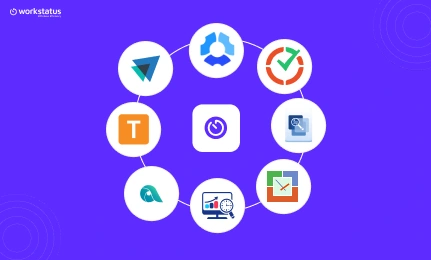Table of Contents
Managing remote teams on a budget can feel like herding cats on Zoom while your bank account watches in horror. But who needs a fancy office when your team can thrive from their living rooms?
Gone are the days of ping-pong tables and free kombucha. Today’s teams rely on strong Wi-Fi and the right tools, not venture capital. Your employees would prefer practical remote team management tools over unnecessary office agendas.
While large corporations invest millions in “return to office” mandates, innovative disruptors transform downtime into productive work. The latest research from Owl Labs and Global Workplace Analytics shows that 74% of employees feel happier working remotely.
Sure, remote work has challenges, like figuring out if your project manager is busy or just pretending. However, mastering affordable remote team management while keeping costs in check is key to building a successful startup.
Let’s dive into understanding startup team management.
Why Remote Teams Are the Future for Startups?
Let’s discuss why remote teams aren’t just a temporary fix but a strategic advantage for modern startups. The FlexJobs Work Insights Survey reveals that 95% of professionals desire remote work in some capacity, whether hybrid or fully remote.
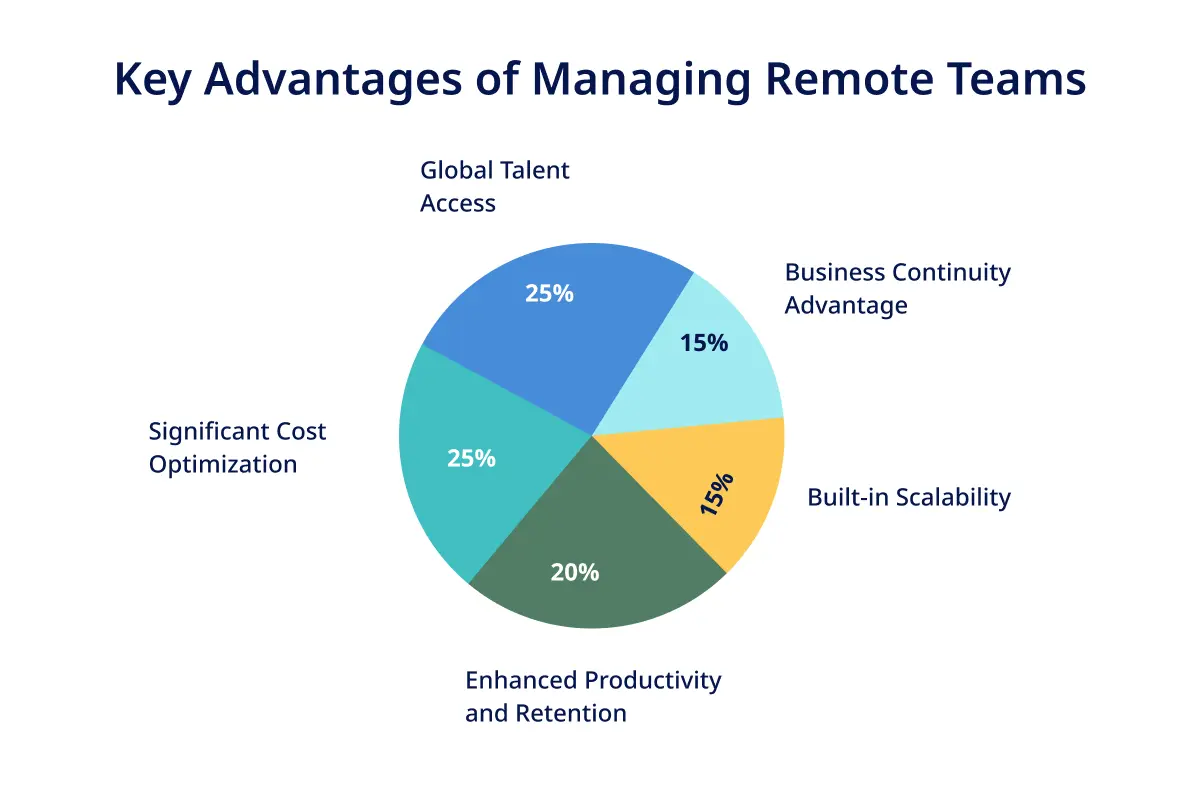 Here is why:
Here is why:
Global Talent Access
Living without geographical bounds is liberating and presents fantastic opportunities. Thanks to remote budget-friendly team solutions, your startup can manage a brilliant developer in Stockholm or an effective marketing strategist in Singapore. This ensures that one can develop very diverse teams with different points of view, thus arriving at better solutions.
Significant Cost Optimization
The cost savings of implementing remote workforce management for distributed teams are not limited to reducing office space costs only. The lack of physical necessities can make startups invest a large proportion of money in products, brand management, or customers. These savings can provide more time or room for maneuvering in a strategic context.
Enhanced Productivity and Retention
Working away from the office is usually a way of balancing your employees’ working and personal lives. Employees are more productive when they can organize work around their best working hours and spare time not spent commuting.
Further, remote work has become one of the biggest retention strategies on the market—satisfied with their jobs, your most valuable employees do not need to change companies for a higher salary.
Built-in Scalability
Another advantage is that remote teams are inherently scalable. Are you looking for fresh talent for a new project? Or even cutting staff during challenging economic circumstances? Remote setups allow all team members to be changed without repeatedly planning for new office space.
Business Continuity Advantage
Recent years have shown us the importance of the right startup team management, which means a very flexible one. Remote teams automatically exclude a range of possibilities—your startup will inevitably be able to keep going no matter what happens in the world.
Now, considering the management of a startup team, it is necessary to look at the difficulties and their solutions related to remote teams.
Challenges and Solutions for Managing Remote Teams
Here are common challenges and their solutions to managing remote teams:
High Operational Costs
Challenge: Maintaining a remote setup can still increase costs with software subscriptions, hardware needs, and internet reimbursements.
Solution:
- For essential operations, use free or budget-friendly tools like Google Workspace, Slack (free tier), and Trello.
- Opt for remote team management tools like Workstatus, which combine multiple functionalities in one platform, saving money on separate software.
Inefficient Communication
Challenge: Miscommunication or lack of clarity often leads to missed deadlines and frustration.
Solution:
- Establish clear communication protocols, like daily check-ins and preferred channels for specific discussions (e.g., Slack for quick updates and email for formal communication).
- Use remote workforce management tools like Zoom or Microsoft Teams for regular video meetings to foster better understanding.
Tracking Productivity Without Micromanaging
Challenge: Striking the balance between monitoring work and giving employees autonomy can be tricky.
Solution:
- Implement affordable remote team management tools like Workstatus to monitor work hours and productivity transparently.
- Focus on deliverables and results rather than hours worked to promote trust and accountability.
Building Team Collaboration
Challenge: Remote work can create silos, making collaboration a challenge.
Solution:
- Collaborative tools like Miro can be used for brainstorming, and Google Docs can be used for shared projects.
- Schedule regular team-building activities like virtual trivia nights or informal coffee chats.
Employee Engagement and Morale
Challenge: Remote employees may feel isolated or disconnected, leading to low morale and engagement.
Solution:
- Recognize achievements through virtual shout-outs or small rewards.
- Offer professional development opportunities like online courses or skill-building workshops.
Time Zone Differences
Challenge: Coordinating across multiple time zones can disrupt workflows and meetings.
Solution:
- Use scheduling tools like Workstatus to find overlapping work hours.
- Encourage asynchronous communication, where team members work and respond on their schedules while adhering to deadlines.
Onboarding Remote Employees
Challenge: Integrating new hires remotely can feel impersonal and disorganized.
Solution:
- Create a comprehensive onboarding plan with clear timelines and milestones.
- Use video tutorials, welcome kits, and scheduled introductions to help new employees feel valued and informed.
By tackling these challenges with practical, cost-effective solutions, startups can build a high-performing remote team without straining their budget.
Transforming Remote Team Management with Workstatus
Managing remote teams effectively requires affordable remote team management, and Workstatus is built to meet the challenge. With features that boost productivity, enhance accountability, and streamline processes, Workstatus empowers remote teams to excel without missing a beat.
Check out the following features:
Web-Based Time Tracker
![]() To optimize work, Workstatus offers a web-based time tracker. Team members can log their hours easily from any device, whether at a fixed desk or on wheels.
To optimize work, Workstatus offers a web-based time tracker. Team members can log their hours easily from any device, whether at a fixed desk or on wheels.
Managers get real reports that offer breakdowns used to estimate time use. This makes it possible to make decisions based on evidence to improve productivity and efficiency. This feature provides accountability for every task, which is important for building trust inside the team.
Shift Management Made Simple
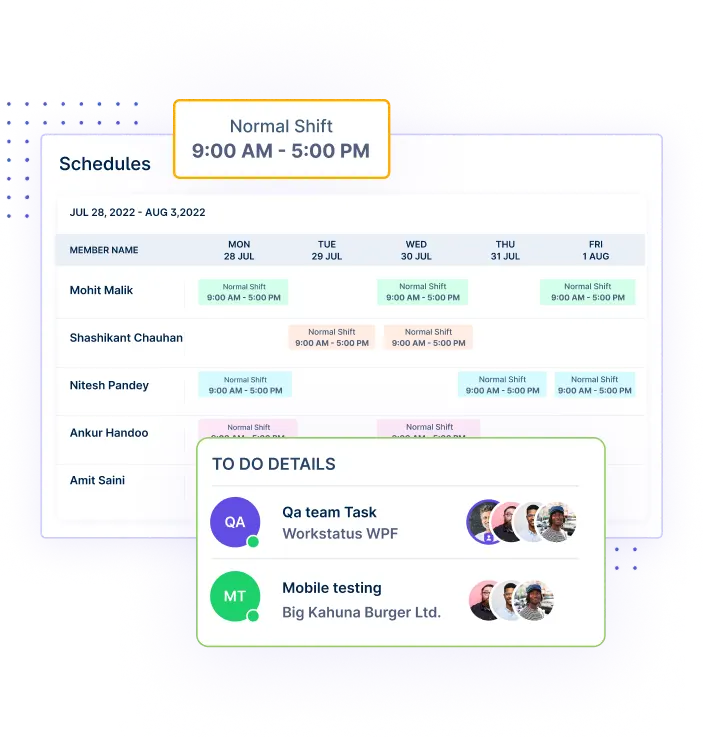 Remote shift coordination has never been easier. The next Workstatus’s core component is shift management, an intuitive tool that helps managers create, edit, and distribute shifts at the workplace with only a few clicks.
Remote shift coordination has never been easier. The next Workstatus’s core component is shift management, an intuitive tool that helps managers create, edit, and distribute shifts at the workplace with only a few clicks.
There are always notifications and reminders to follow, and tracking is done in real-time, so there will be no gaps. Workstatus proves more convenient for handling complex shift schedules.
Preventing Employee Burnout
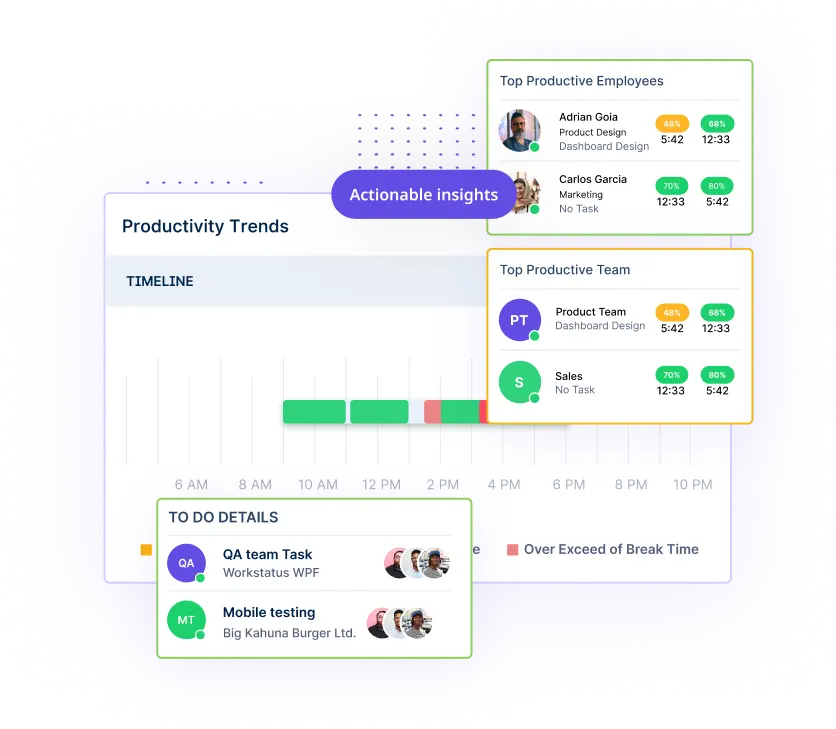 Workstatus also helps avert burnout by providing tools like smart breaks and workload calculations that contribute to a healthy work-life balance.
Workstatus also helps avert burnout by providing tools like smart breaks and workload calculations that contribute to a healthy work-life balance.
Workstatus helps employers oversee working hours, detect cases of overworking employees, and recommend when employees should have breaks so they remain healthy and focused. This approach lowers turnover and inspires people to stay with the organization.
Live-Location Tracking for Enhanced Visibility
![]() Workstatus’s live-location tracking feature is a real deal for teams on-site or in multiple locations.
Workstatus’s live-location tracking feature is a real deal for teams on-site or in multiple locations.
This feature helps you effortlessly track your remote team’s work hours and availability in real-time. With its user-friendly dashboard, you can instantly see who’s online and working, making team coordination and project management simpler across all time zones.
Attendance Tracking Made Effortless
![]() Bye-bye to manual attendance tracking with Workstatus’s attendance tracking feature. It is advantageous for the employees to punch their time cards and for the managers to see the attendance records in detail in one go.
Bye-bye to manual attendance tracking with Workstatus’s attendance tracking feature. It is advantageous for the employees to punch their time cards and for the managers to see the attendance records in detail in one go.
It records working patterns, including lateness or failure to log in, and thus checks and ensures order within the working team.
Overtime Tracker for Smarter Workforce Planning
![]() Businesses can use the overtime tracker feature in Workstatus to ensure employees are paid for overtime while preventing employees from being overworked.
Businesses can use the overtime tracker feature in Workstatus to ensure employees are paid for overtime while preventing employees from being overworked.
Thus, using automated calculations and analytics, managers can address workloads more strategically and avoid overloading team members.
Workstatus is one of the best cost-effective remote work solutions for managing remote teams. From tracking time and attendance to preventing burnout and optimizing workflows, it equips businesses with the tools they need to thrive in today’s remote-first world.
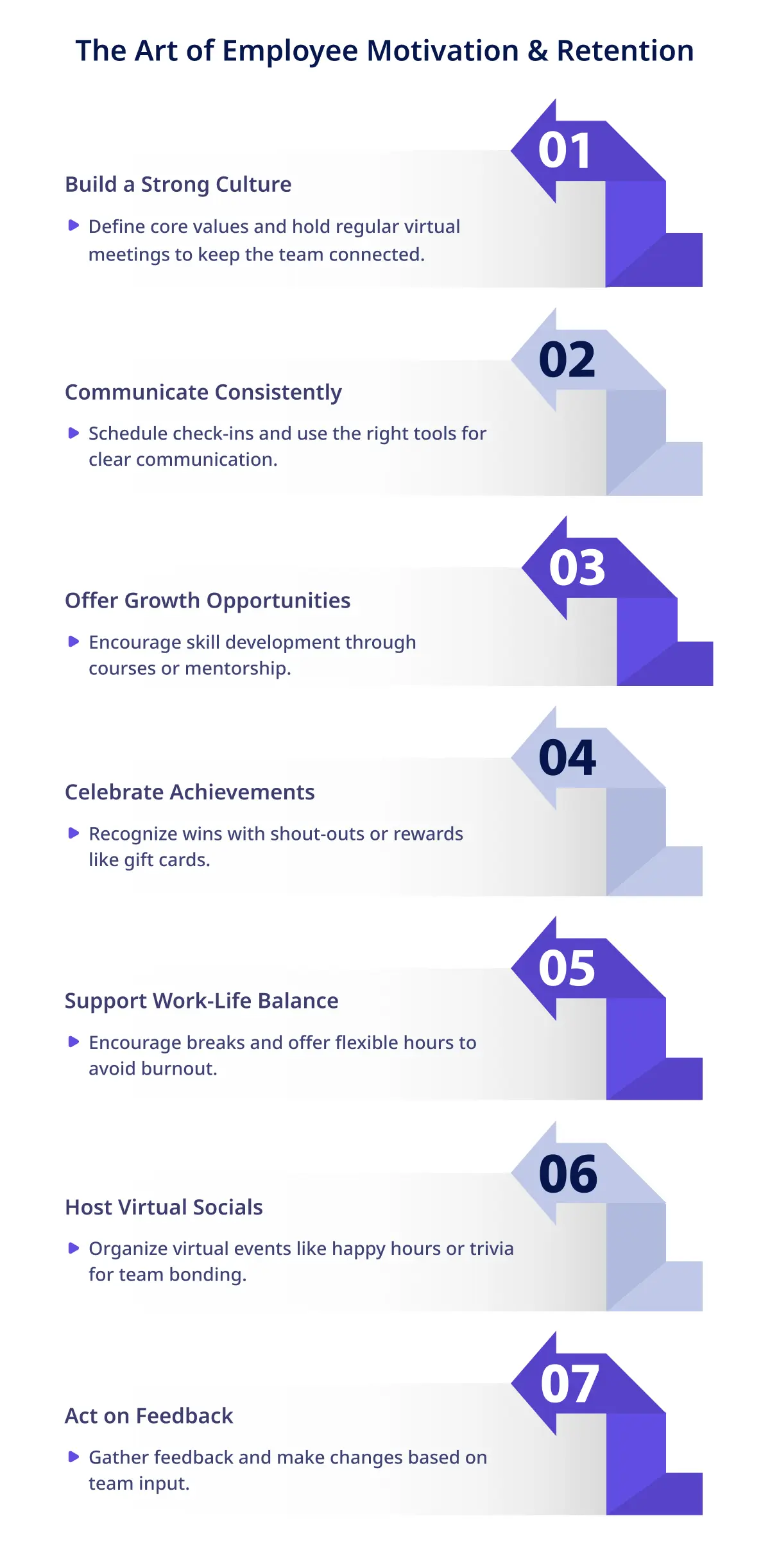
5 Prevailing Mistakes to Avoid
Here are the five prevailing mistakes to avoid in managing remote teams on a budget:
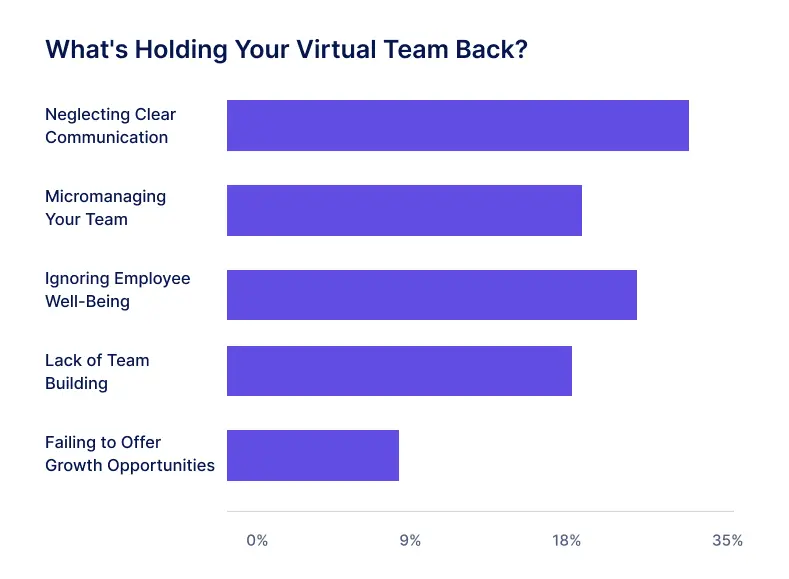
1. Neglecting Clear Communication
Mistake: Managing expectations or not commonly explaining what needs to be done when working remotely with a team.
Solution: Include clear objectives, targets, time frames, and team members’ roles and responsibilities. Set regular checkpoints through mobile apps such as Slack for communication updates and Workstatus to stay on top of tasks. Use video calls when information sharing is critical.
2. Micromanaging Your Team
Mistake: It is unwise to check in too frequently or to micromanage people, as this will erode trust and reduce motivation.
Solution: Minimise emphasis on procedures and methodologies. Relax and allow your team to schedule themselves and their work. Tools like Workstatus enable one to track time without pressure and give people their independence at work.
3. Ignoring Employee Well-Being
Mistake: Failure to monitor how remote employees feel, think, and physically behave puts them at risk of burning out in their jobs.
Solution: Organize break time, give some personal time, and support the work-life balance concept. Provide more personal and professional assistance for the employee, such as health and other relevant wellness programs.
4. Lack of Team Building
Mistake: Employees in remote teams also do not require social contacts and engagement activities to feel part of a team and motivated.
Solution: Schedule virtual team-building events such as trivia contests, informal coffee breaks, office parties, or meetings with jests and jokes. This is a great way to maintain morale and create a team feeling.
5. Failing to Offer Growth Opportunities
Mistake: Not providing avenues for learning, skill development, or career advancement, which can lead to frustration and eventual turnover.
Solution: Enhance employees’ knowledge through online courses, training programs, mentorship, or cross-over projects within departments. Always follow up with team members on their career aspirations and ensure they are given incentives to stay motivated with the organization.
Therefore, when operating a startup, it is advisable to avoid blunders to create a loyal and motivated remote employee.
Closing Thoughts
Thus, managing remote teams on a budget is achievable with the right tools and strategies.
By using affordable remote team management solutions like Workstatus, startups can streamline operations, boost productivity, and maintain accountability without overspending. Features like time tracking, shift management, and attendance monitoring enable efficient management, while smart workforce management solution for burnout prevention and location tracking ensure employee well-being and performance.
With cost-effective remote work solutions, remote teams can thrive, and startups can focus on growth without the financial strain.




